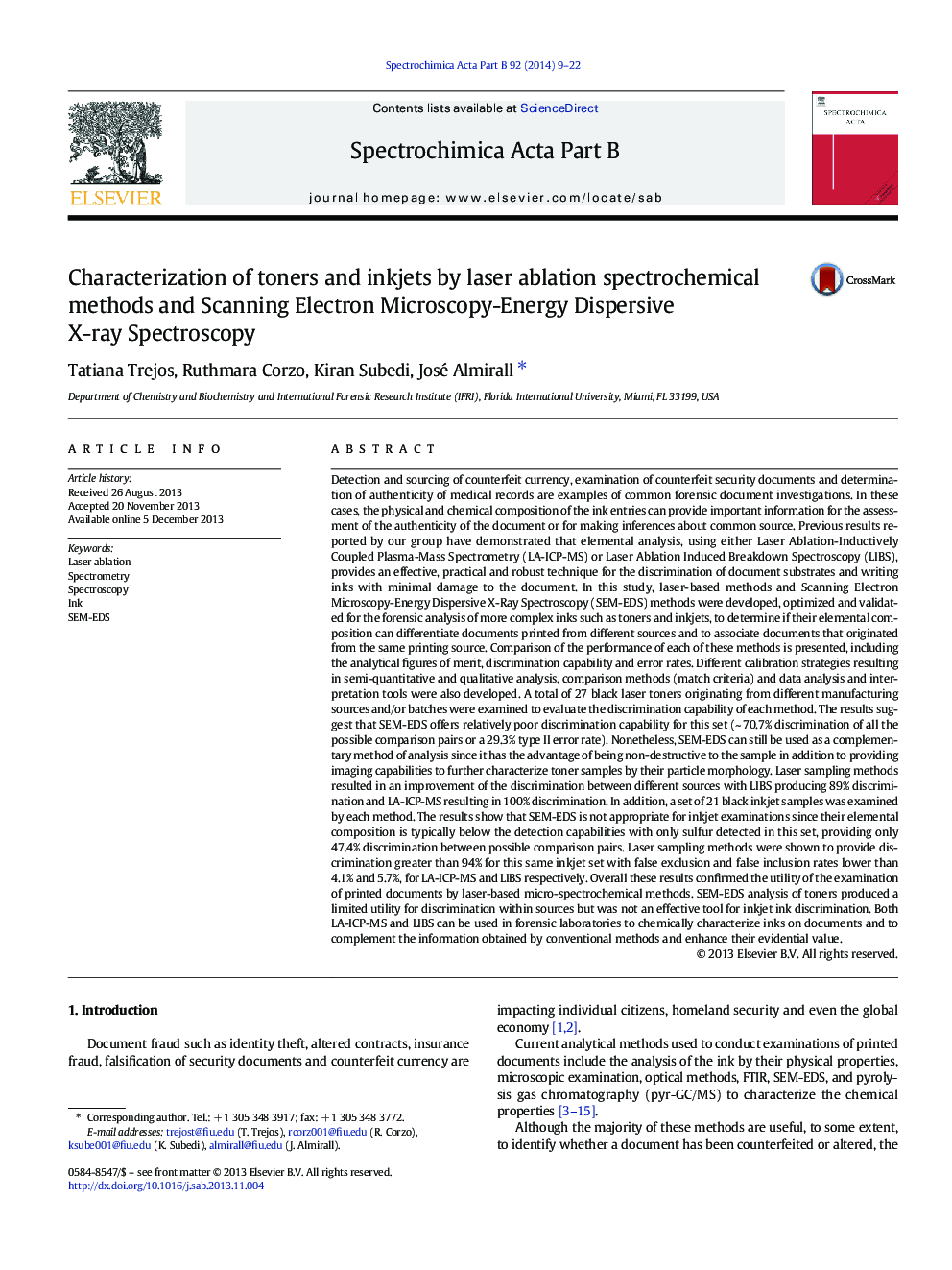| کد مقاله | کد نشریه | سال انتشار | مقاله انگلیسی | نسخه تمام متن |
|---|---|---|---|---|
| 1239697 | 1495709 | 2014 | 14 صفحه PDF | دانلود رایگان |

• We describe the analysis of printer inks on paper using LA-ICP-MS, LIBS and SEM-EDS.
• Analytical figures of merit and the relative discrimination power for each technique is described.
• Both LA-ICP-MS and LIBS provide excellent discrimination between different printer sources.
Detection and sourcing of counterfeit currency, examination of counterfeit security documents and determination of authenticity of medical records are examples of common forensic document investigations. In these cases, the physical and chemical composition of the ink entries can provide important information for the assessment of the authenticity of the document or for making inferences about common source. Previous results reported by our group have demonstrated that elemental analysis, using either Laser Ablation-Inductively Coupled Plasma-Mass Spectrometry (LA-ICP-MS) or Laser Ablation Induced Breakdown Spectroscopy (LIBS), provides an effective, practical and robust technique for the discrimination of document substrates and writing inks with minimal damage to the document. In this study, laser-based methods and Scanning Electron Microscopy-Energy Dispersive X-Ray Spectroscopy (SEM-EDS) methods were developed, optimized and validated for the forensic analysis of more complex inks such as toners and inkjets, to determine if their elemental composition can differentiate documents printed from different sources and to associate documents that originated from the same printing source. Comparison of the performance of each of these methods is presented, including the analytical figures of merit, discrimination capability and error rates. Different calibration strategies resulting in semi-quantitative and qualitative analysis, comparison methods (match criteria) and data analysis and interpretation tools were also developed. A total of 27 black laser toners originating from different manufacturing sources and/or batches were examined to evaluate the discrimination capability of each method. The results suggest that SEM-EDS offers relatively poor discrimination capability for this set (~ 70.7% discrimination of all the possible comparison pairs or a 29.3% type II error rate). Nonetheless, SEM-EDS can still be used as a complementary method of analysis since it has the advantage of being non-destructive to the sample in addition to providing imaging capabilities to further characterize toner samples by their particle morphology. Laser sampling methods resulted in an improvement of the discrimination between different sources with LIBS producing 89% discrimination and LA-ICP-MS resulting in 100% discrimination. In addition, a set of 21 black inkjet samples was examined by each method. The results show that SEM-EDS is not appropriate for inkjet examinations since their elemental composition is typically below the detection capabilities with only sulfur detected in this set, providing only 47.4% discrimination between possible comparison pairs. Laser sampling methods were shown to provide discrimination greater than 94% for this same inkjet set with false exclusion and false inclusion rates lower than 4.1% and 5.7%, for LA-ICP-MS and LIBS respectively. Overall these results confirmed the utility of the examination of printed documents by laser-based micro-spectrochemical methods. SEM-EDS analysis of toners produced a limited utility for discrimination within sources but was not an effective tool for inkjet ink discrimination. Both LA-ICP-MS and LIBS can be used in forensic laboratories to chemically characterize inks on documents and to complement the information obtained by conventional methods and enhance their evidential value.
Journal: Spectrochimica Acta Part B: Atomic Spectroscopy - Volume 92, 1 February 2014, Pages 9–22